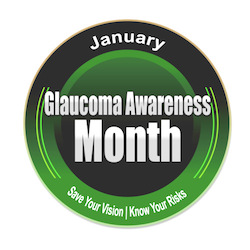January is Glaucoma Awareness Month | Know Your Risks


This month is Glaucoma Awareness Month.
Do you have glaucoma? How do you know?
Glaucoma is a leading cause of blindness around the world. Your chances of developing this blinding disease increase with age and other factors (read below).
The National Eye Institute estimates about 3 million Americans have the disease and this will increase to 4.2 million by 2030. The disease is already found in over 60 million people around the world.
There is no single type of glaucoma. The disease destroys the optic nerve by a variety of mechanisms. The most common type of glaucoma in the United States is called “open angle glaucoma.”
Risk Factors for Glaucoma
Does someone in your family have glaucoma? Having a family is history of glaucoma is a major risk factor. Other risk factors for developing glaucoma include;
- African Americans over the age of 40
- Everyone >60 years old, but especially Latino/Hispanic patients
- Positive Family History
- Asian and/or farsighted patients
If you have glaucoma, talk to your family about your disease and the importance of early detection.
Symptoms of Glaucoma
There are usually no symptoms of glaucoma until it’s too late.
This is especially true in patients with “open angle glaucoma” – the most common type found in the U.S.
In almost all cases of glaucoma, the peripheral or “side” vision is affected first. As the disease progresses only your central vision may remain until it is completely lost in very advanced situations.
Pain, tearing, redness, blurriness and nausea are symptoms of “angle closure” glaucoma due to sudden and dramatic increases in eye pressure.
Detection of Glaucoma
The diagnosis of glaucoma can be made with a complete eye examination. Remember that there are usually NO SYMPTOMS. Early detection and treatment is essential to preventing vision loss.
We routinely examine our patients for evidence of glaucoma at all of our offices. Here are some the diagnostic tests we use to evaluate your risk of glaucoma;
- Eye pressure – aka Intraocular Pressure (IOP)
- Visual field testing
- Pachymetry – measuring your corneal thickness which can influence eye pressure readings
- Optical Coherence Tomography (OCT) can directly measure optic nerve damage/loss
- Dilated Eye Examination – allows us to directly examine your optic nerve
If you have a family history or are concerned about glaucoma. Call us to make an appointment or email us!
We look forward to seeing you.
Gregory Scimeca, M.D.
Ophthalmologist and Medical Director
Burlington County Eye Physicians
Eye Professionals, LLC (Millville, NJ)
Eye Physicians and Surgeons of Bucks County (Langhorne, PA)
